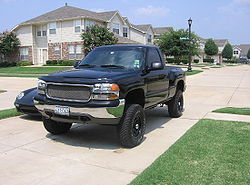
Suspension lift
Encyclopedia

Jeep
Jeep is an automobile marque of Chrysler . The first Willys Jeeps were produced in 1941 with the first civilian models in 1945, making it the oldest off-road vehicle and sport utility vehicle brand. It inspired a number of other light utility vehicles, such as the Land Rover which is the second...
, truck, SUV and offroad enthusiasts to raise the ride height of their vehicle. Suspension lifts (also referred to as lift kits or leveling kits) enable steeper approach, departure, and breakover angles, higher ground clearance, and helps accommodate larger wheels and tires. Due to the increased center of gravity
Center of gravity
In physics, a center of gravity of a material body is a point that may be used for a summary description of gravitational interactions. In a uniform gravitational field, the center of mass serves as the center of gravity...
, maximum safe operating angles are reduced with a lift kit.
Each manufactured vehicle usually requires a specific lift kit, and the types of kits vary based on the type of drivetrain that the vehicle has. Kits can be as simple as lift blocks (spacers placed between the axles and leaf springs) and coil spring/strut spacers and extended shocks; to replacement control arms, trailing arms, and custom four-link systems. Suspension lifts also impact other factors, such as drive shaft length, steering geometry and brake lines. Legality is often an issue when installing suspension lifts, as many jurisdictions have varying laws on vehicle ride height and placement of lights and bumpers.
Leaf Spring Lift

Leaf spring
Originally called laminated or carriage spring, a leaf spring is a simple form of spring, commonly used for the suspension in wheeled vehicles...
suspensions. Leaf springs offer exceptional articulation, a large payload and can take a substantial amount of abuse. With the correct methods they can be modified to help your vehicle carry more weight, have better articulation and fit large oversized tires. Some vehicles may be equipped with front and rear leaf springs or just rear springs.
Some methods of lifting are good for the rear, but not for the front, such as lifting blocks. Lifting the rear with blocks is a common way to achieve the desired height. This is done by installing a block, of the desired height of lift, in between the leaf spring and leaf spring perch and installing longer u-bolts. It is a bad method for the front primarily because of safety issues while braking. When braking, the front wheels create the majority of the braking force. The block moves this lateral force, caused by braking, higher above the axle than it did in the stock form. This can cause the block to become displaced from its location and result in total loss of control. For further explanation see this link;http://www.4wheeloffroad.com/techarticles/suspension/131_0708_4x4_front_lift_blocks/index.html.
A more accepted way to build up the leaf springs is by using an add-a-leaf. This is done by inserting an extra leaf into the vehicle's leaf pack. Using the add-a-leaf will increase the height, but sometimes makes the suspension ride rough because of the added spring rate. A complete description of how this is done is shown at this link; http://www.jedi.com/obiwan/jeep/addaleaf.html. With an adequate budget, the best way to lift with leaf springs is to buy a new set with the lift built in. When using an add-a-leaf you are relying on the integrity of the old springs. They may be a bit worn out, so when the lift is installed, the proposed 2 inch leafs may only have lifted the truck 1.5 inches. The new leaf spring pack will not be fatigued and will give the "true" lift desired. These packs can be bought at various increments of lift and can be combined with lifting shackles to give the proper set-up.

